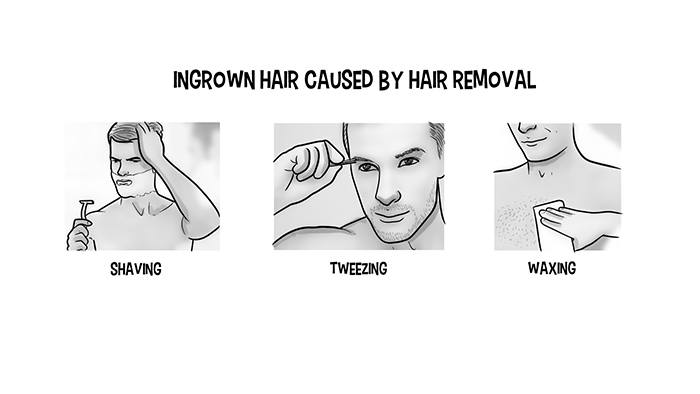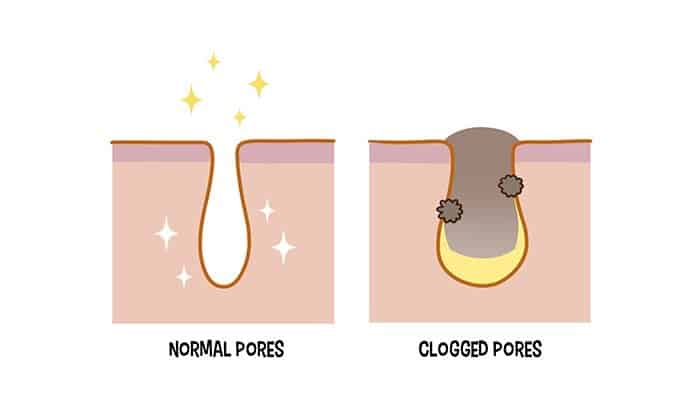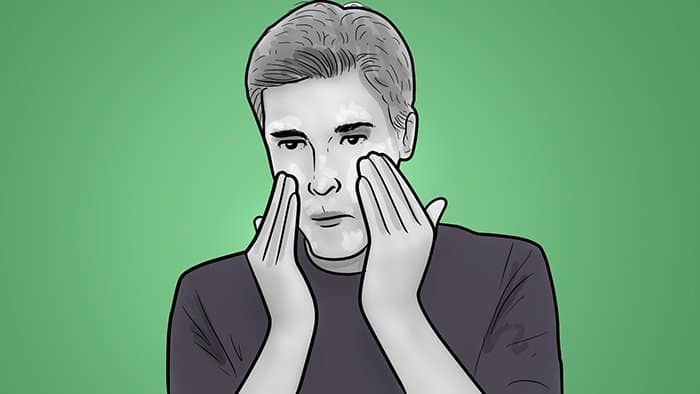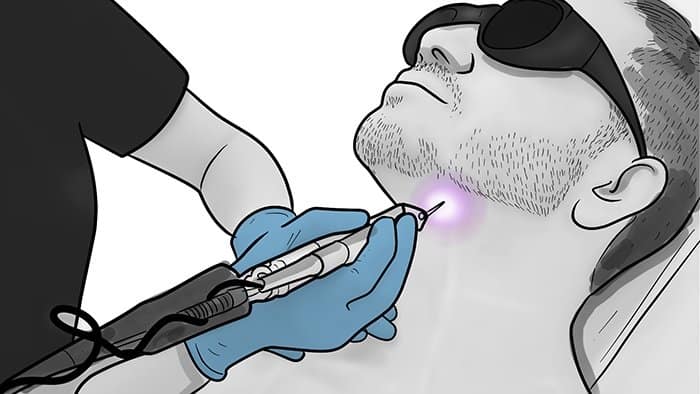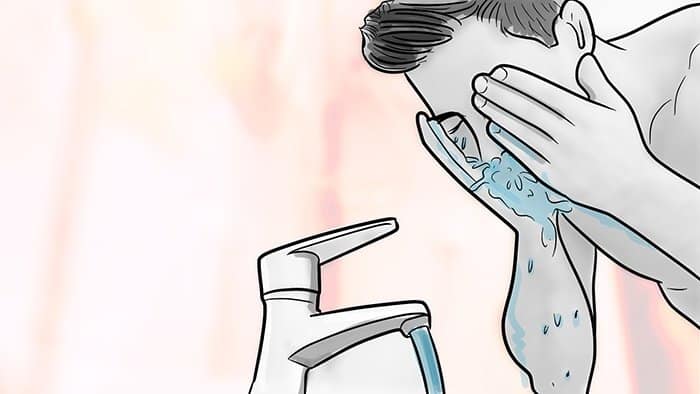How to Prevent & Get Rid Of Ingrown Facial Hair With These 18 Methods
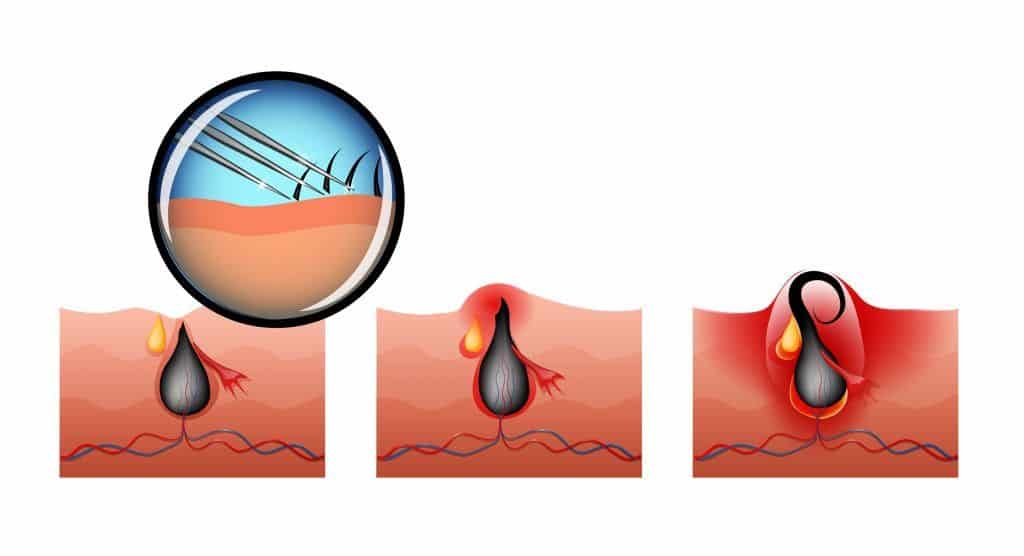
Ingrown facial hair is not an issue to take lightly. True, there are worse maladies, but that’s not much solace for someone who has to endure the itching, burning, and other irritations caused by an ingrown hair.
If left untreated, ingrown hair can cause an infection in the area of the skin where it occurs, create unsightly bumps and discoloration, and be downright painful.
We’ll take a closer look at ingrown hair in this article, including its causes, how to treat it, and how to prevent it. Ingrown hair isn’t fun, and, if you suffer from it, we feel your pain.
The Primary Causes of Ingrown Facial Hair
To pick up where we left off in our introduction, an ingrown hair occurs when a small hair beneath the skin doesn’t grow outward through the skin. Instead, the tip of the hair grows sideways or curls back into the hair follicle.
The result isn’t pleasant: an ingrown hair creates plenty of skin irritation, including small bumps on the skin that often resemble tiny pimples.
However, they don’t occur on the face only – ingrown hairs may appear on the neck, armpits, pubic region, legs, even on your buttocks.
Not fun.
If you suffer from ingrown hair, you may wonder, like most people, where the hell they came from and how they happened. The fact is, there are many causes of ingrown hair, which we’ll explore here.
You also should know that ingrown hair can happen to anyone, so there’s no need to feel singled out.
Among the most common symptoms of ingrown hair are small, solid, and rounded bumps on the skin plus pustules, skin darkening, pain, and itching. Again, not fun.
Ingrown hair caused by hair removal
By hair removal, we mean shaving, tweezing, and/or waxing the hair. Shaving is an obvious culprit, because ingrown hair often appears in the beard area, including on the neck, where whiskers also grow. Shaving your head can also cause ingrown hair on your scalp.
Removing hair, from no matter what part of the body, leaves the hair with a sharp tip and close to the skin’s surface. Those hairs may grow sideways or curl back into the hair follicle and become stuck under the surface of the skin.
Incorrect shaving techniques, which we’ll cover later when discussing how to prevent ingrown facial hair, can cause ingrown hair.
If you shave, do so in the direction of your facial hair growth. Doing so decreases the chances of developing ingrown hairs and skin irritation.
You should also make sure your razor is sharp. Dull razors are more likely to cause ingrown hairs and skin irritation. You can use a razor that has multiple blades to minimize the number of passes you have to make over an area while shaving.
Don’t apply too much pressure when shaving, as this can cause your razor to push or cut the hair underneath your skin, causing it to become ingrown. You can also use a shaving gel or lotion to help soften your facial hair before you shave. Once you’re done, apply an aftershave balm or moisturizer to help soothe irritated skin and reduce the risk of ingrown hairs.
Ethnicity
African-American and Latino men, who typically have thick or curly hair, often develop pseudofolliculitis, a type of ingrown hair commonly known as “razor bumps.”
Again, the hair that grows back after shaving – or hair that’s been waxed or removed with tweezers – has a sharper edge and can easily poke back through the skin or get trapped beneath the skin’s surface.
Dead skin cells
Everyone’s skin contains dead skin cells; our body is in a continuous state of shedding old skin while replacing it with new. Dead skin cells that remain on the skin may create a barrier that hinders the natural growth of hair while clogging pores.
The presence of dead skin cells emphasizes the need for regular exfoliation of the skin, in which you remove the cells – but more on exfoliation later.
Clogged pores
If you use excessive skincare products, you increase the risk of getting an ingrown hair. Not all products clog pores, but those that do can cause hair to reverse its route and grow back toward the base.
Lack of moisturizer
Skin that’s too dry and not well-hydrated is skin that’s more prone to ingrown facial hair. Healthy skin that’s properly moisturized provides the platform upon which hair grows in the right direction.
Use of wax and tweezers
Waxes used for beard styling may change the direction of hair growth and lead to ingrown hair. Also, the forceful movement of removing hair with tweezers can cause ingrown facial hair.
8 Ways How to Treat Ingrown Hair Safely & Easily (A simple, illustrated guide)
If there’s any good news about ingrown hair, it’s that it often goes away on its own, but that pretty much takes care of it when it comes to ingrown hair “positives,” unfortunately.
The problem is that ingrown hair often doesn’t go away by itself and may become infected, darken the skin, or leave behind a tell-tale scar, because you’ve picked and scratched at it. But don’t despair: there are several ways with which to remove ingrown beard hair.
1. Treating Ingrown Hair With Medicine
You may want to pay your doctor or dermatologist a visit when an ingrown hair becomes infected or extremely bothersome. He or she may decide a course of action that includes medicine, such as a steroid that you rub on your skin to lessen the swelling and irritation.
Or, your doc may prescribe an antibiotic to treat the ingrown hair infection. The antibiotic may come in pill form or in a lotion that you rub onto the infected area.
Retinoids, a vitamin A derivative, are another option and come in a liquid, gel, or lotion form, which you apply to your skin. Retinoids also are used to treat a variety of skin irritations and issues, including acne, blackheads, psoriasis, and aging skin.
2. Using a Sharp Device to Remove Ingrown Hair
You may wince when you think of using a sharp device to remove ingrown hairs, but it’s not as gruesome as you may think. Your doctor even may do it for you by making a small cut in your skin with a sterile needle or scalpel to release the embedded hair.
Or, you can do it yourself with a pair of tweezers or a needle. For you squeamish folks, keep in mind that most ingrown hair is close to the skin’s surface and not that hard to pull out (or release) with a needle or the tips of tweezers.
However, there are a couple of disadvantages to using a sharp device to dig out an ingrown hair:
1) you risk scarring
2) you risk infection
Whatever you do, make sure you sterilize the needle or tweezers before you take the DIY route for removing ingrown hair. Your doctor will disinfect your skin with rubbing alcohol to try to prevent infection.
You also should soften the skin by applying a warm towel to it for five to 10 minutes before trying to release the ingrown hair with tweezers.
Also, keep in mind that your goal isn’t to pluck the hair out completely but to straighten it out, so that it doesn’t continue to embed itself under the skin’s surface.
So, what’s the verdict? Is removing ingrown hair on your own by using a sharp device a good idea? The bottom line is that it’s not impossible, but you may want to leave it up to the pros.
They have the proper experience and know-how to do the job correctly while lowering the risk of infection and scarring.
3. Using Beard Oil to Treat Ingrown Hair
Beard oil is like a magic elixir for your beard and the skin beneath it. It hydrates, it makes your beard look better, it makes it more manageable.
We could go on and on about beard oil’s many virtues, but know that it’s a must-have product for your beard grooming kit.
OK, one more thing about beard oil: it also treats ingrown hair. Beard oil’s magic includes opening up the pores of your face while accelerating the release of bacteria and pus caused by ingrown hairs.
Moreover, many beard oils contain antiseptic ingredients, such as tea tree oil, that treat infection and itching.
Many men have experienced positive results when using beard oil to treat ingrown hair – results that happen within one to three days.
Even if beard oil doesn’t treat your ingrown facial hair – but we think it will – it will help your beard to reach its full potential in many ways.
4. Exfoliation: The Secret to Healthy Skin (And Fighting Ingrown Hair)
We’ll get a bit more in-depth about exfoliation when we talk about how to prevent ingrown hair later in the article, but it’s a process that’s often effective for treating ingrown hair.
Exfoliating the skin means giving it a good scrub with a quality exfoliator to remove dead cells from the skin’s surface. Our skin is in a continuous process of regenerating itself while shedding old skin and replacing it with new.
An excess of dead skin cells can clog pores and form a barrier that keeps new hair from breaking through the skin. So, while exfoliating the skin can prevent ingrown hair from forming, it also can gently nudge ingrown hair to the surface and beyond.
Exfoliation also helps remove oils, dirt, and other grime that can trap hair beneath the skin’s surface.
5. Using a Warm Compress to Treat Ingrown Hair
A warm compress, such as a towel soaked with warm water, is another method for treating ingrown facial hair.
The heat generated by the compress will soften the skin and bring ingrown hairs even closer to the surface, thus making it easier to remove them with tweezers.
Repeat the process, if necessary; the embedded hair will work its way to the surface eventually.
6. Always. Be. Moisturizing.
Any efforts for trying to achieve healthy skin, and skin that’s free from ingrown hair, will fall short if you aren’t moisturizing your skin consistently. The last thing you want is for your skin to become overly dry, which makes it even harder to extract an ingrown hair.
Remember, a beard requires a lot of your skin’s natural oil (sebum) to remain hydrated, and sometimes the production of oil can’t keep pace with the growth of your beard. That’s why you must use products such as beard oil and other moisturizers.
7. Laser Treatment For Ingrown Hair: The Last Resort?
You may want to consider laser treatments for your ingrown hair if nothing else works. Laser hair removal is highly effective and used to get rid of unwanted hair over all parts of the body.
The primary reason why laser treatment is so effective is that it gets to the root of the problem. The energy absorbed from the laser helps to remove ingrown hair while preventing it from re-appearing ever again.
Keep in mind that laser hair removal is a permanent solution, because the laser energy absorbed into the hair follicle prevents it from producing hair. Also, keep in mind that laser treatments, while extremely effective, require a series of treatments and don’t come cheap.
Honestly, they may not be a “last resort,” because some people choose to skip all other methods and go directly to laser treatments, they’ll certainly alleviate the problem of ingrown hair.
8. Removing Ingrown Hair With Natural Methods
Not everyone wants to use antibiotics, steroids, sharp objects, etc. to treat ingrown hair. If you fall into that group, you may want to consider various home remedies, including:
A home-brewed exfoliator – You can create your own exfoliation solution by mixing baking soda, sea salt, sugar, and olive oil.
Honey – Honey has many skin-friendly benefits, including that it moisturizes the skin and acts as an antibacterial, which is helpful when dealing with an infection.
It also loosens the skin and helps draw out the ingrown hair, or at least brings it close enough to the surface that you can try to pluck it out.
You’ll need to leave honey on the affected area of your skin for 20 to 30 minutes (or until it dries) to get the best results.
Tea tree oil and aloe vera – Tea tree oil and aloe vera have antibacterial, anti-inflammatory, and antiseptic properties that help heal the skin and treat ingrown hair. You should dilute tea tree oil with water before you apply it to the skin.
Aloe vera is most effective when applied immediately after you shave.
Note: All of the above methods apply for treating ingrown mustache hair and ingrown hairs on your chin.
10 Methods You Can Use to Prevent Future Ingrown Hair
There are times when the formation of an ingrown hair may be out of your control – such as being a man with particularly curly or thick hair – but not all hope is lost, by any means. Consider the following methods for preventing ingrown hair.
Exfoliate! – We talked earlier about the importance of removing dead skin cells, which is what exfoliation is all about. It not only helps prevent ingrown hair from forming but also enhances the overall health of your skin in many ways.
Removing dead skin cells allows newer, healthy skin to grow and thrive, while also preventing your pores from clogging. Exfoliators also can pull up ingrown hair and eliminate the need to use something more painful, such as tweezers.
The best exfoliators contain natural ingredients, as well as scrubbing beads that dig deep into the skin while removing dead skin cells. Among those we like is Brickell’s Renewing Face Scrub for Men .
Whichever exfoliator you choose, make sure that it’s suitable for your type of skin, whether you have sensitive skin, dry skin, oily skin, etc.
It’s not necessary to exfoliate your skin every day. Every other day should suffice – or even just twice a week, if you have sensitive skin that’s prone to irritation.
1. Shave With The Grain
Shaving against the grain is a common cause of ingrown hairs. There’s nothing overly complicated about this step, but do take some time to learn the “grain” of your hair. Going with the grain doesn’t always mean vertically, because some hair grows diagonally.
2. Use the Proper Razor Angle
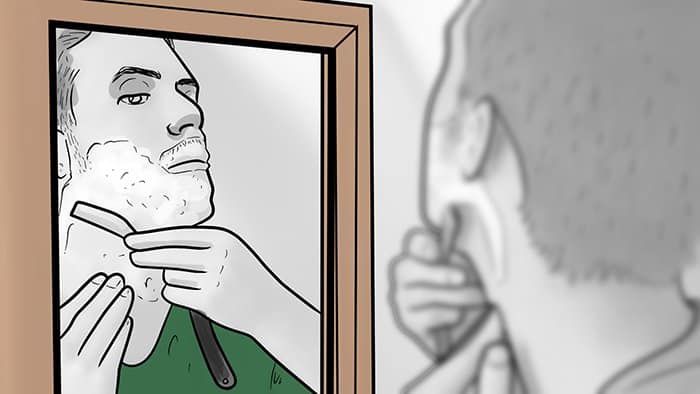
3. Use a Sharp, Clean Razor
Dull razor blades not only prevent you from getting a close shave but can cause an uneven cut, which may lead to ingrown hair. Change your blades as needed to ensure that they’re sharp enough to give you a close shave.
Here’s another hint: whether you’re using a traditional razor or an electric razor, there’s no need to press the blades tightly against the skin. You want to apply some pressure, yes, but sharp blades should handle the heavy work of shaving and trimming.
One of the several disadvantages of using a razor with a dull blade is that it takes more strokes to get a clean shave, which raises your risk for developing ingrown hair.
Finally, try to make as few passes as possible with your razor while also rinsing the blade after every stroke. Rinsing your blades provides further lubrication while getting rid of any hair or shave gel that can make it harder to remove whiskers during the first pass.
4. Consider Using an Electric Razor
While an electric razor, at least most of them, won’t provide quite as close of a shave as a traditional razor, you may want to consider using one if you have issues with ingrown hairs.
An electric razor will leave a bit of stubble behind, which isn’t a bad thing if the hair closest to your skin tends to curl in the wrong direction – like back into your skin.
But don’t cop out and buy a cheap electric shaver. At the least, check out our review of the best razors before you grab the first one that catches your eye online or on the store shelf.
5. Moisturize Your Skin Before Shaving
Always take the time and care to moisturize your skin before you shave. You can wet your skin with warm water (or shave right after you get out of the shower) or apply a lubricating gel or a pre-shave oil.
6. Moisturize Your Skin After Shaving
Use a post-shaving product, such as aftershave, to hydrate and refresh your skin. Also, apply a wet washcloth to your skin after shaving to reduce irritation.
7. Use a Well-Rounded Pre-Shave Routine
The routine you follow before the blade meets your skin should include proper moisturizing and also the use of a top-notch facial cleanser to get the skin ready for the shave.
Of course, you’ll also want to apply a quality shave cream that enables the razor’s blades to glide easily across your face and neck without pulling and tugging.
Ideally, choose a shave cream, foam, or lotion that’s alcohol-free and won’t dry out skin that you’ve worked so hard to moisturize. Also, let the lotion or gel soak into your skin for a minute or two to help soften your facial hair.
8. Rub Your Face Every Day
Exfoliation aside, it never hurts to rub your face gently every day with a wet washcloth to help loosen and potentially remove stubborn ingrown hair.
9. Use a Quality Beard Brush
A quality beard brush, particularly one with boar’s hair bristles, helps enhance your exfoliation efforts.
The brush’s stiff bristles help keep your beard free from tangles and knots and also draw out some of the dirt and grime that collect on your facial follicles every day.
10. Consider Using Other Methods
Perhaps the simplest way to prevent ingrown facial and neck hair is to use a high-quality razor with sharp blades that provide a clean cut. But there are ways to prevent ingrown hair, such as laser removal, that aren’t as conventional and certainly not as budget-friendly.
Conclusion
Ingrown facial hair affects a lot of men and women, and it’s not an issue to take lightly. There are, however, a variety of strategies and treatment options for treating ingrown hair effectively while also preventing it from occurring again and again.
Do you suffer from ingrown facial hair? If so, how do you treat it? We always welcome your comments and suggestions and hope to hear from you.
